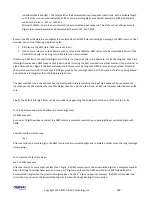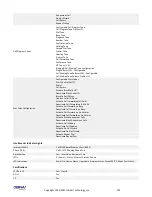
Copyright 2010-2013 Obihai Technology, Inc.
196
Notes:
-
A terminal may be a trunk or another endpoint.
-
Abbreviated terminal names are case-insensitive
-
number and number-to-call
are literal strings, such as 14089991234
-
digit-map
is just any proper digit map, such as (1xxx|xx.); make sure to include the enclosing parentheses
-
spoofed-caller-number
is a literal string, such as 14081112233, to be used as the caller number for making a new
call on the specified trunk
-
(M
label
) is a named digit map where
label
is the abbreviated name of any terminal that has a digit map defined:
SP1, SP2, LI, PP, PH, or AA
-
$2 is an internal variable containing the called number of this outbound call, after any digit map transformation in
the matched
callee
object
-
Callee-list
can be empty, which implies the single
callee
object @, which means any called number. The succeeding
‘:’ can be omitted also when
callee-list
is empty
More notes on the
arg
,
cid
,
and
target
objects:
-
The
cid
object inside an
arg
object is optional. If omitted, it implies no caller-ID spoofing when making the call on
the specified trunk. The succeeding ‘>’ can be omitted if
cid
is omitted.
-
The
target
object inside an
arg
object is optional. If omitted, it implies the
target
$2, which means to call the
original called number after applying any necessary digit map transformation implied by the rule. The preceding ‘>’
cannot be omitted if
target
is omitted but not the cid.
-
arg
object is optional. If omitted, it implies the
arg
with the
target
$2 and no
cid
An outbound call matches a rule if its called number matches one of the
callee
objects of the rule.
Callee
objects are tested
in the order left and right, and the first matched
callee
will win. Rules are also checked in the order left to right, and the first
matched rule will win. Therefore it is important that you place the more specific rules first in the OutboundCallRoute if
multiple rules can potentially match the same outbound call.
Note that every endpoint also has a digit map defined. The user dialed number is completely processed with the endpoint’s
digit map first before it is passed to the OutboundCallRoute for routing decision. Therefore the number used for matching
call routing rules has already incurred the transformations, if any, implied by the digit map. Remember this fact when
crafting your own OutboundCallRoute.
OutboundCallRoute Examples
:
1)
sp1
OR
{SP1}
OR
{:SP1}
OR
{@:Sp1}
(all equivalent)
This rule says: Make all calls using SP1 Service, without any caller-id spoofing or digit transformation
2)
{(<#:>|911):li},{**0:aa},{***:aa2},{(Mpli):pli},{(<**1:>(Msp1)):sp1},{(<**2:>(Msp2)):sp2},{(<**8:>(Mli)):li},{(<**9:>(
Mpp)):pp}
This is the default OutboundCallRoute for the PHONE port. It says:
Содержание OBi100
Страница 54: ...Copyright 2010 2013 Obihai Technology Inc 54...
Страница 55: ...Copyright 2010 2013 Obihai Technology Inc 55...
Страница 58: ...Copyright 2010 2013 Obihai Technology Inc 58...
Страница 75: ...Copyright 2010 2013 Obihai Technology Inc 75...
Страница 100: ...Copyright 2010 2013 Obihai Technology Inc 100...
Страница 109: ...Copyright 2010 2013 Obihai Technology Inc 109 SP1 SP2 SP3 and SP4 Services...
Страница 126: ...Copyright 2010 2013 Obihai Technology Inc 126...
Страница 135: ...Copyright 2010 2013 Obihai Technology Inc 135...
Страница 140: ...Copyright 2010 2013 Obihai Technology Inc 140...
Страница 157: ...Copyright 2010 2013 Obihai Technology Inc 157...
Страница 158: ...Copyright 2010 2013 Obihai Technology Inc 158...
Страница 159: ...Copyright 2010 2013 Obihai Technology Inc 159...
Страница 174: ...Copyright 2010 2013 Obihai Technology Inc 174...
Страница 184: ...Copyright 2010 2013 Obihai Technology Inc 184 Here is a screen short of the File Sharing Settings device web page...
Страница 185: ...Copyright 2010 2013 Obihai Technology Inc 185...
















































